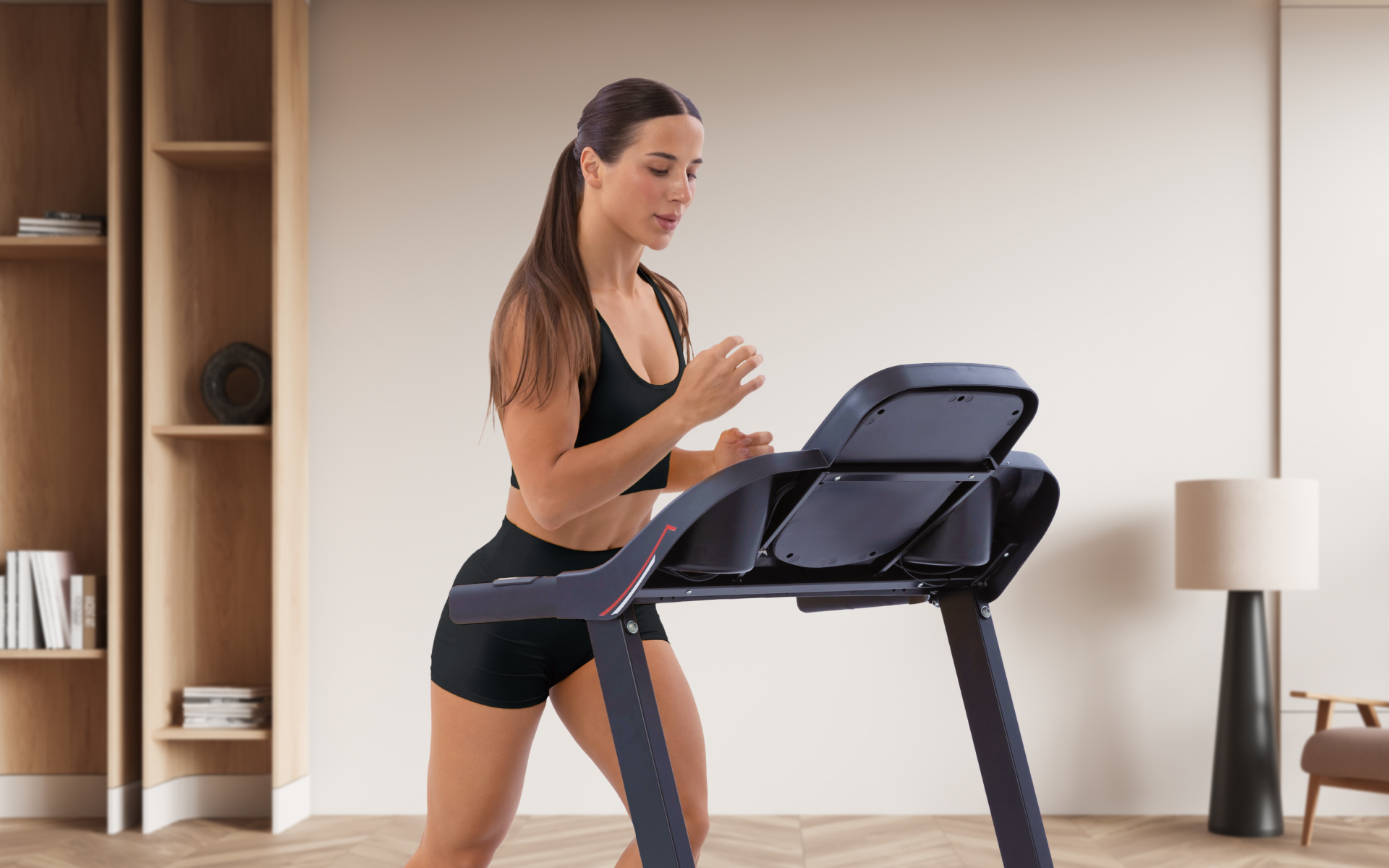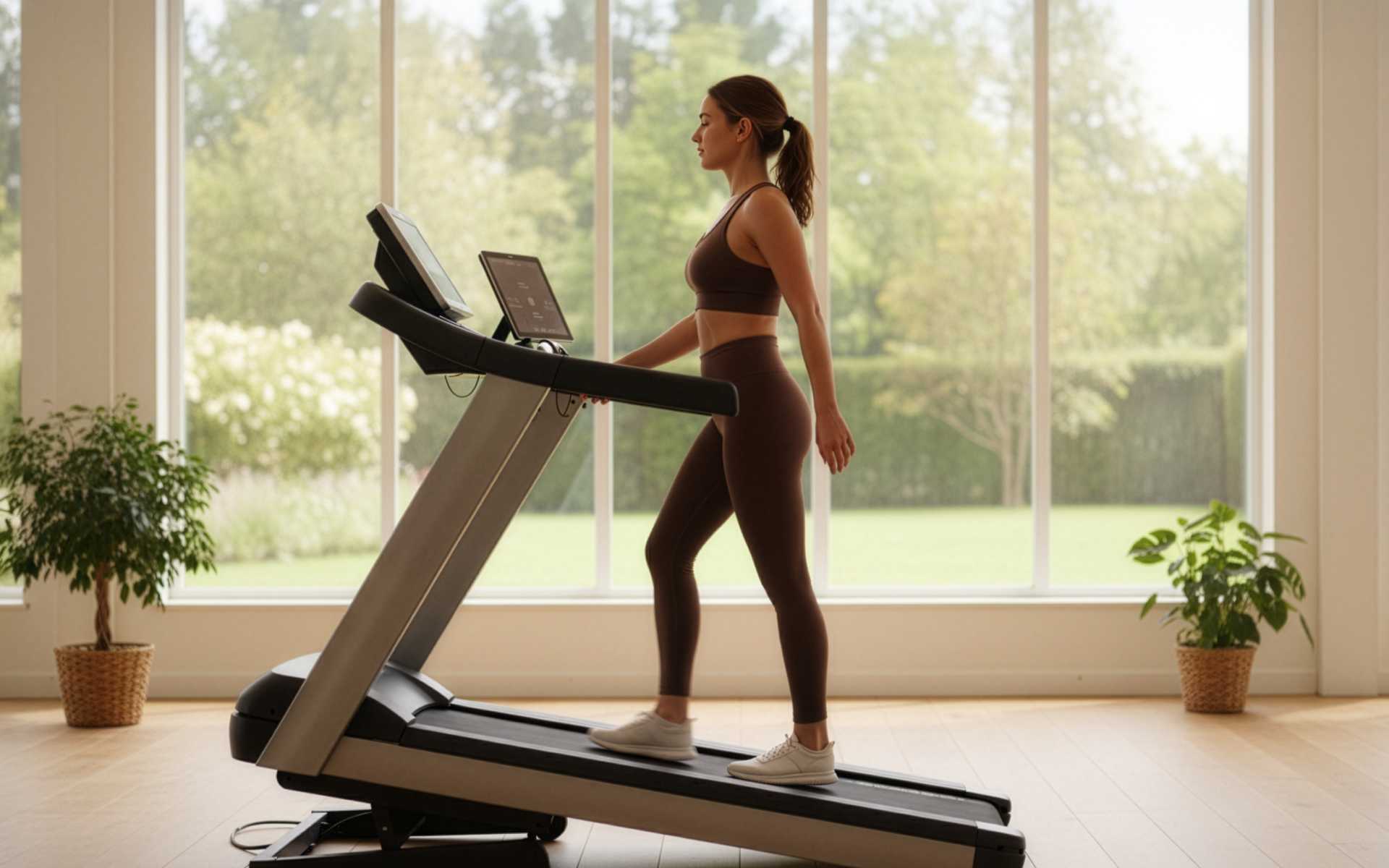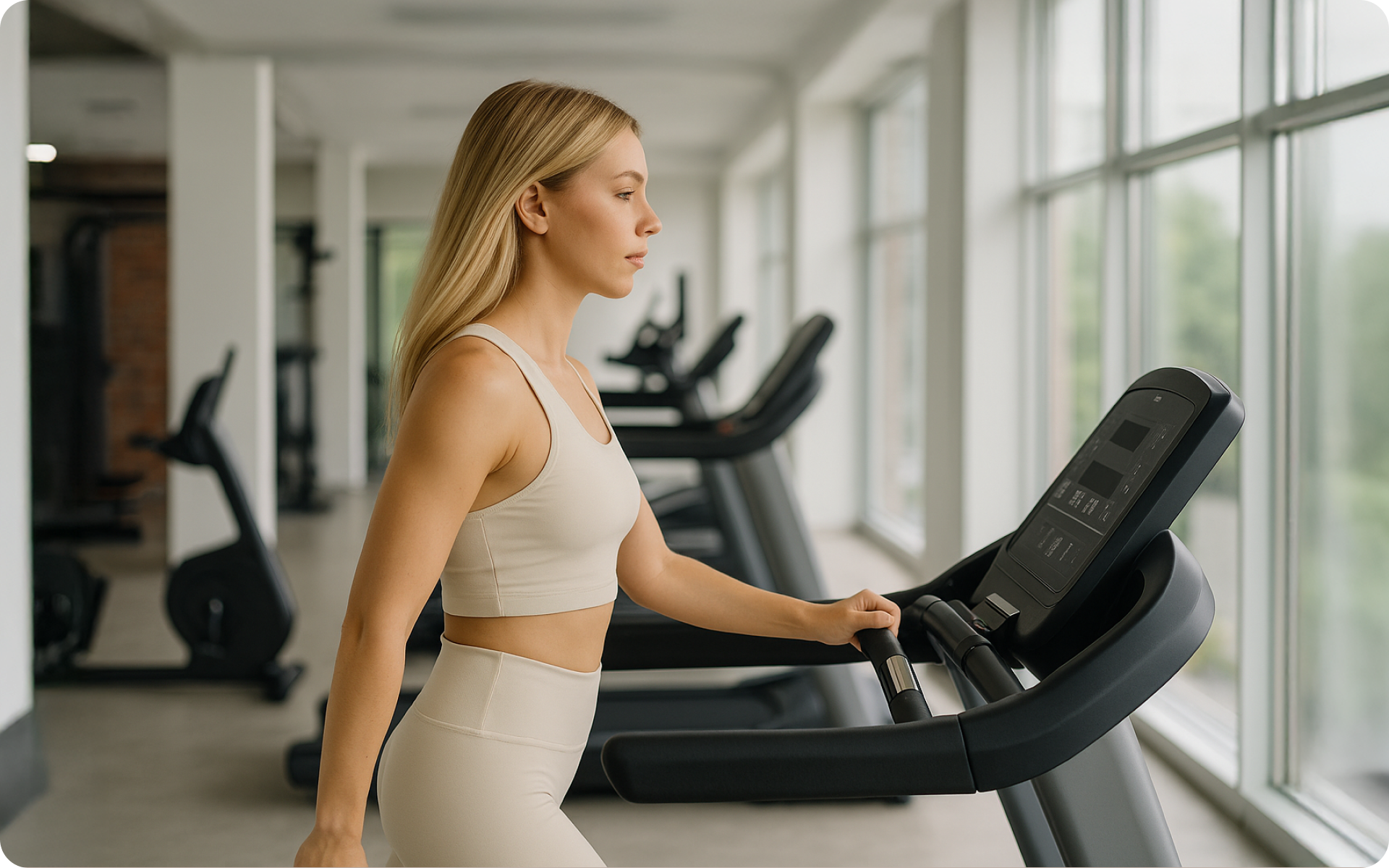If you’re looking to improve your cardio fitness, incline walking is the way to go. It’s one of the proven ways to get your heart pumping, increase your metabolism, and burn more calories. By increasing the incline, you simulate walking uphill, which makes your muscles work harder. It’s also low-impact, which means you can perform more work with less risk of injury and more calories burned. It’s also highly flexible, providing suitable training for all levels. Altogether, it’s a highly effective exercise for a greater loss of unnecessary fat.
In this blog post, we’ll explore how incline walking burns fat and how you can make the most of it on your treadmill, so let’s dive in.
Is Walking on an Incline Good for Weight Loss?
Incline walking can absolutely be an effective way to lose weight. Here’s how:
It Can Burn Calories
You must note that the number of calories you burn depends on various factors, including your weight, the intensity, and the duration of your exercise. Compared to walking on a flat surface, incline walking burns more calories, as a greater demand is placed on your body, which makes your muscles work harder.
For example, a 155-pound (70 kg) person walking on a flat surface at 3.5 mph (5.6 kph) for 1 hour can burn approximately 267 calories. However, if the same person maintains the same speed but walks uphill, they could burn up to 422 calories (1).
A 2013 study comparing incline walking/running to flat running found that a small 2% incline can increase your heart rate by 5.06% while a 7% incline can raise your heart rate by almost 15%. This higher heart rate and increased oxygen demand result in more calories burned than walking on level ground (2).
Another study revealed that walking on a 5% incline increases the metabolic cost by 52% compared to walking on flat ground. With a 10% incline, the metabolic cost can go up to 113% (3).
In addition, incline walking may be able to help you burn more calories after you work out if your workout is intense enough. Incline walking can help maintain muscle mass, which results in maintaining your RMR and increased calories burned.
To summarize, the higher calorie burn and increased metabolic cost from incline walking can translate into more efficient fat loss over time, particularly when combined with a balanced diet.
Reasons why BetterMe is a safe bet: a wide range of calorie-blasting workouts, finger-licking recipes, 24/7 support, challenges that’ll keep you on your best game, and that just scratches the surface! Start using our app and watch the magic happen.
It Can Improve Heart Health
Walking, jogging, and running are good ways to improve your cardiovascular fitness. When you walk uphill, your heart rate increases rapidly by up to 10% compared to walking on a flat surface (2).
Gentler on the Joints
The best aspect of incline walking is it puts minimal strain on the knees and joints. This makes it suitable for elderly people, individuals with knee or back issues, or those who are recovering from knee replacement surgery.
Incline walking aids recovery by strengthening the muscles around the knee joints. In fact, some physical therapists recommend it as a part of rehabilitation (4).
Therefore, incline walking can be an effective exercise to lose weight for people with such conditions. As previously mentioned, incline walking allows for a more controlled and gradual increase in intensity. This can reduce the risk of overexertion while still benefiting you with muscle training and fat burning.
Read more: BetterMe Walking Plan Overview (2025)
Can You Lose Stomach Fat from Incline Walking?
Yes, incline walking can be incredibly effective in helping you lose belly fat. In addition to burning a ton of calories, it engages all the muscle groups in your core, including your abs, hips, and back, burning fat and increasing your strength.
But before you go ahead with an incline walking program for stomach fat, you should note that you can’t spot-reduce fat. Incline walking leads to overall fat loss, including your stomach fat. Therefore, you can lose fat from your entire body, including your belly.
Here are a few incline walking benefits and how incline walking can help you lose stomach fat:
Increases Calorie Burn
Walking is a simple yet effective exercise for supporting weight loss as it helps you burn calories consistently. Adding an incline makes it even more beneficial by raising your heart rate, engaging more muscles, and increasing calorie burn than walking on a flat surface.
Engages Your Core
To understand how incline walking contributes to stomach fat loss, it’s important to recognize that your stomach area has several key muscles (5). When you walk on an incline, these muscles are engaged in various ways:
- Transverse Abdominis and Rectus Abdominis: These muscles activate to stabilize your body and prevent tripping. They can keep your core stable and strong enough to support your upper body and assist in a forward lean.
- Internal and External Obliques: As you pump your arms to help propel yourself uphill, the natural twisting motion of your body and arm swings can engage your internal and external obliques. This can develop a stronger waistline.
- Hip Flexors: Lifting your knee toward your body while walking on an incline targets your hip flexors. The muscles that connect your lower abs to your hips effectively engage and strengthen your lower core.
Builds Muscle Mass
Incline walking is a weight-bearing exercise that can help people gain muscle mass. According to the Mayo Clinic, the more lean muscle mass, the more quickly you can burn calories.
Building more muscle helps you burn more calories even when you’re just chilling as it speeds up your metabolism. And if you’re aiming to lose fat, burning more calories can definitely help with that.
Is 30 Minutes of Incline Walking Enough to Burn Fat?
Well, 30 minutes can be more than enough to burn fat when all other lifestyle factors are aligned with this goal. Of all the practices, the 12-3-30 workout is quite a popular fad among fitness enthusiasts. The 12-3-30 treadmill incline workout refers to walking at a 12% incline at a speed of 3 miles per hour for 30 minutes.
The CDC recommends a healthy weight loss of 1 to 2 pounds per week. To lose 1-2 pounds a week, you need to burn 500 to 1,000 calories more than you consume each day while following a lower-calorie diet and participating in regular physical activity.
For example, walking for 30 minutes may burn around 125 calories for a person who weighs 150 pounds, but incline walking can potentially double the calorie burn (7). As incline walking engages more muscle groups, it can increase overall calorie expenditure during the workout and may even help you continue burning calories for a short period afterwards.
Intense sweat sessions, working weight loss tips, lip-smacking recipes come in one package with the BetterMe: Health Coaching app—all at your fingertips, start transforming your life now!
The 30-minute window also helps maintain consistency, allowing you to integrate incline walking into your routine without feeling overly fatigued. To make the most of your 30-minute incline walking, you can alternate between low and high inclines each day.
This challenges your body and helps burn more fat while keeping your workout fun and interesting!
Read more: Treadmill 10,000 Steps: Your Guide to Crushing the Step Challenge
Is It Better to Walk Fast or Slow on an Incline For Weight Loss?
Generally, we all believe that increasing the speed and intensity can help us burn more fat in less time. However, according to the latest fitness trend on social media, people are ditching high speeds for a slow walk on an incline. But does this result in weight loss?
High-intensity workouts use glucose as the primary fuel source. On the other hand, lower-intensity exercises such as slow walking rely on fat as an energy source. The rate of fat loss depends on your calorie deficit – using a treadmill for weight loss is an effective way to achieve this.
Walking briskly on an incline can instantly boost your heart rate and lead to higher calorie expenditure. The faster you walk, the more energy your body uses and the more calories you burn in a set amount of time. If you’re short on time and want a HIIT (high-intensity interval training) treadmill workout for fat loss, this pace may suit you.
In contrast, walking slowly on an incline may emphasize your leg and core muscles, helping you burn more fat during the workout. This method can be suitable for beginners or those who are recovering from knee injuries, as it’s low-impact, gradual, and also friendly on the joints.
If you’re short on time, go for the fast-paced 20-minute treadmill workout, as it helps you burn more calories in less time. However, if you want to burn calories steadily for longer, you should opt for a slow-incline walk. Alternate between slow and fast treadmill HIIT workouts for the best results to accelerate fat loss.
Walking on an incline can maximize your glute activation (8). The added resistance of uphill terrain makes walking a more potent glute strengthener than walking on a flat surface. Yes, the increased calorie expenditure and targeted muscle work of incline walking can lead to leaner-looking legs. Yes, daily incline walking is generally safe and effective exercise, as long as you listen to your body, start gradually, and increase the intensity and duration over time to prevent injury. Holding onto treadmill handrails, particularly during incline walking, is usually discouraged as this reduces workout effectiveness and may lead to poor posture and injury risks.Frequently Asked Questions
Does incline walking grow your glutes?
Will incline walking slim your legs?
Is it OK to walk on an incline every day?
Is it bad to hold onto the treadmill while walking on an incline?
The Bottom Line
Elevating your walk by adding an incline offers remarkable advantages over strolling on level ground. You can experience a greater calorie burn, enhanced cardiovascular health, a boosted metabolism, and overall improved fitness levels. Notably, incline walking is a fantastic, low-impact option for older adults and individuals who are recovering from knee injuries or surgery, allowing them to exercise comfortably.
It’s always wise to have a quick chat with your doctor before you add incline walking into your exercise routine, just to be sure it’s right for you. When you first transition from flat walking to an incline, your muscles may feel a little bit more challenged, which can lead to some initial soreness, so take it easy at the start. Also, if you have lower-back pain, it’s best to avoid setting the incline too steeply, as this could potentially aggravate your back.
You should get personalized guidance on the best incline for a safe and effective workout by consulting a physical therapist.
DISCLAIMER:
This article is intended for general informational purposes only and does not serve to address individual circumstances. It is not a substitute for professional advice or help and should not be relied on for making any kind of decision-making. Any action taken as a direct or indirect result of the information in this article is entirely at your own risk and is your sole responsibility.
BetterMe, its content staff, and its medical advisors accept no responsibility for inaccuracies, errors, misstatements, inconsistencies, or omissions and specifically disclaim any liability, loss or risk, personal, professional or otherwise, which may be incurred as a consequence, directly or indirectly, of the use and/or application of any content.
You should always seek the advice of your physician or other qualified health provider with any questions you may have regarding a medical condition or your specific situation. Never disregard professional medical advice or delay seeking it because of BetterMe content. If you suspect or think you may have a medical emergency, call your doctor.
SOURCES:
- Calories Burned Walking | Calculator & Formula (2020, captaincalculator.com)
- A Paradigm of Uphill Running (2013, pmc.ncbi.nlm.nih.gov)
- Predicting the Metabolic Cost of Incline Walking from Muscle Activity and Walking Mechanics (2015, pmc.ncbi.nlm.nih.gov)
- The effect of incline walking on lower extremity and trunk mechanics in older adults (2025, sciencedirect.com/)
- Abdominal Muscles (2024, my.clevelandclinic.org)
- WEIGHT LOSS AND IMPROVED QUALITY OF LIFE (n.d., ace-pt.org)
- What is 12-3-30? People are losing weight with this walking treadmill workout (2024, today.com)
- Unveiling the Dynamics: Kinematics and Activation Patterns of Gluteus Maximus in Inclined Treadmill Sprinting (2024, link.springer.com)











